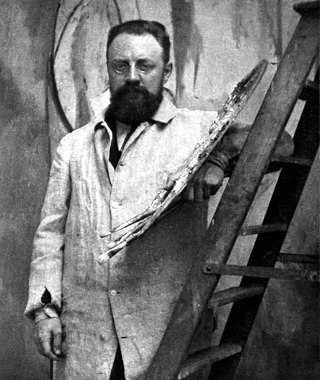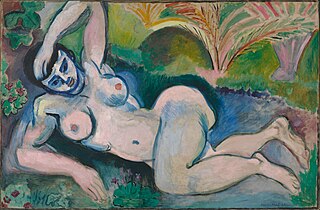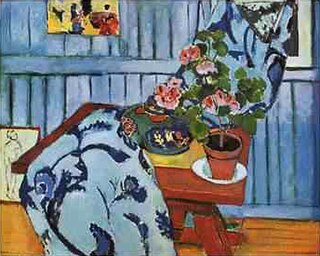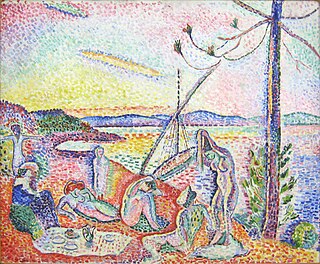
Henri Émile Benoît Matisse was a French visual artist, known for both his use of colour and his fluid and original draughtsmanship. He was a draughtsman, printmaker, and sculptor, but is known primarily as a painter. Matisse is commonly regarded, along with Pablo Picasso, as one of the artists who best helped to define the revolutionary developments in the visual arts throughout the opening decades of the twentieth century, responsible for significant developments in painting and sculpture.

Blue Nude (Souvenir of Biskra) (French: "Nu bleu, Souvenir de Biskra"), an early 1907 oil painting on canvas by Henri Matisse, is located at the Baltimore Museum of Art as part of the Cone Collection.

Paul Rosenberg was a French art dealer. He represented Pablo Picasso, Georges Braque and Henri Matisse. Both Paul and his brother Léonce Rosenberg were among the world's major dealers of modern art.

Dance (La Danse) is a painting made by Henri Matisse in 1910, at the request of Russian businessman and art collector Sergei Shchukin, who bequeathed the large decorative panel to the Hermitage Museum, in Saint Petersburg. The composition of dancing figures is commonly recognized as "a key point of (Matisse's) career and in the development of modern painting". A preliminary version of the work, sketched by Matisse in 1909 as a study for the work, resides at MoMA in New York, where it has been labeled Dance (I).

Nude in a Black Armchair is an oil on canvas painting by Pablo Picasso. Painted on 9 March 1932, a time at which Picasso lived in Boisgeloup outside Paris, it is the first and largest of a series of paintings Picasso completed that year of his mistress Marie-Thérèse Walter. The painting was purchased by Les Wexner at Christie's auction in 1999 for the value of $45.1 million.

Le bonheur de vivre is a painting by Henri Matisse. Along with Picasso's Les Demoiselles d'Avignon, Le bonheur de vivre is regarded as one of the pillars of early modernism. The monumental canvas was first exhibited at the Salon des Indépendants of 1906, where its cadmium colors and spatial distortions caused a public expression of protest and outrage.

The Red Studio is an oil on canvas painting by French artist Henri Matisse from 1911. It is held in the collection of the Museum of Modern Art, in New York.

Asia is a painting by Henri Matisse. It is an oil on canvas painting from 1946.

Landscape at Collioure is an oil-on-canvas painting by French artist Henri Matisse from 1905. It is typical of his Fauvist style of the period. It is part of the collection of the Museum of Modern Art, in New York.

Still Life with Geraniums is a 1910 oil on canvas painting by Henri Matisse.

The Boat is a paper-cut from 1953 by Henri Matisse. The picture is composed from pieces of paper cut out of sheets painted with gouache, and was created during the last years of Matisse's life.

Woman on a High Stool is an oil painting on canvas by the French artist Henri Matisse from early 1914. It is held in the Museum of Modern Art, in New York.

View of Notre-Dame is an oil painting by Henri Matisse from 1914. It is held in the Museum of Modern Art, in New York.

Luxe, Calme et Volupté is a 1904 oil painting by the French artist Henri Matisse. Both foundational in the oeuvre of Matisse and a pivotal work in the history of art, Luxe, Calme et Volupté is considered the starting point of Fauvism. This painting is a dynamic and vibrant work created early on in his career as a painter. It displays an evolution of the Neo-Impressionist style mixed with a new conceptual meaning based in fantasy and leisure that had not been seen in works before.

Fauvism is a style of painting and an art movement that emerged in France at the beginning of the 20th century. It was the style of les Fauves, a group of modern artists whose works emphasized painterly qualities and strong colour over the representational or realistic values retained by Impressionism. While Fauvism as a style began around 1904 and continued beyond 1910, the movement as such lasted only a few years, 1905–1908, and had three exhibitions. The leaders of the movement were André Derain and Henri Matisse.

Lizzie Plummer Bliss, known as Lillie P. Bliss, was an American art collector and patron. At the beginning of the 20th century, she was one of the leading collectors of modern art in New York. One of the lenders to the landmark Armory Show in 1913, she also contributed to other exhibitions concerned with raising public awareness of modern art. In 1929, she played an essential role in the founding of the Museum of Modern Art. After her death, 150 works of art from her collection served as a foundation to the museum and formed the basis of the in-house collection. These included works by artists such as Paul Cézanne, Georges Seurat, Paul Gauguin, Henri Matisse, Pablo Picasso and Amedeo Modigliani.
Bathers by a River, also known as Bathers at the River and occasionally referred to as simply Bathers, is a large 1917 oil-on-canvas painting by French artist Henri Matisse. Matisse began painting the canvas in 1909 and finished the painting in the fall of 1917, making it one of three pictures he painted during the Battle of Verdun.

Goldfish is an oil-on-canvas still life painting by French visual artist Henri Matisse. Painted in 1912, Goldfish was part of a series that Matisse produced between the spring and early summer of 1912.

French visual artist Henri Matisse was known for his use of color and draughtsmanship. In the early 20th century, Matisse became a leader of the Fauvism art movement, which was an early movement in the broader Post-impressionist era.

















